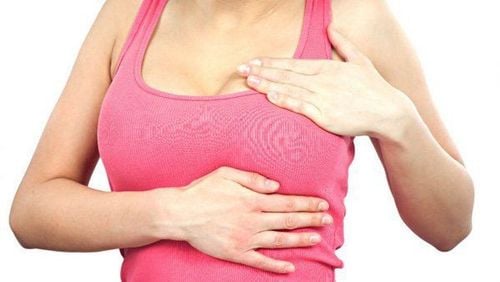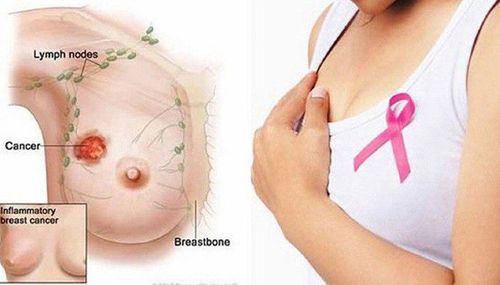This is an automatically translated article.
The article was professionally consulted by Dr. CKII Phung Thi Phuong Chi - Oncologist, Oncology Center - Vinmec Central Park International General Hospital.Most benign breast lesions do not increase the risk of breast cancer. However, some situations can lead to certain risks.
1. Learn about benign breast lumps
According to Dr. CCII Phung Thi Phuong Chi - Oncology Center (Vinmec Central Park International General Hospital), benign breast tumor is a fairly common condition in women. Benign breast lesions can cause pain, swelling, infection, nipple discharge, and changes in the skin's surface...
Breast lump pain can be cyclical or irregular. often. Cyclic pain occurs in response to changes in hormone levels in the body; accompanied by symptoms such as: breasts may be swollen, sensitive and painful than before menstruation. Non-cyclical pain usually occurs on one side of the chest and in a specific area. In rare cases, non-cyclical breast pain can be a sign of breast cancer.
Trắc nghiệm: Những lầm tưởng và sự thật về ung thư vú
Ung thư vú có tỷ lệ tử vong cao nhất ở nữ giới khiến họ rất lo sợ bản thân mắc phải căn bệnh này. Tuy nhiên, không ít chị em có những hiểu biết thái quá về ung thư vú. Thử sức cùng bài trắc nghiệm sau sẽ giúp bạn loại bỏ được những nghi ngờ không đúng về căn bệnh này.
Bài dịch từ: webmd.com
2. Benign breast tumor classification
Dr. Phung Thi Phuong Chi said, medically divided types of benign breast tumors into three types: non-reproductive type, typical hyperplasia and atypical hyperplasia. In particular, non-reproductive breast lesions include normal mammary cells, most commonly cysts and fibroadenomas. Breast cysts are quite small, often disappear on their own or can be removed with a needle. Simple fibroadenomas usually shrink and disappear on their own. However, if they continue to grow larger, surgical removal is recommended.
For typical hyperplastic breast tumor, the mammary gland cells are increased in number but completely normal, without the presence of abnormal cells with malformed nuclei. In fact, the typical tumor-type appearance may slightly increase the long-term future risk of breast cancer. Therefore, depending on the case, the doctor will recommend monitoring, ensuring the tumor does not grow or consulting surgical removal.

Particularly in cases of atypical hyperplastic breast tumors (presence of abnormal cells with malformed nuclei), most often lead to a high risk of developing breast cancer in the future. Therefore, when this type of breast tumor is detected, doctors often prescribe surgery to remove the germ of cancer, and maintain monitoring for a long time. As such, most benign breast lesions do not increase the risk of breast cancer; but benign breast tumors are dangerous no longer depending on the cellular properties of the tumor, how it is detected and treated.
For specific cases, doctors will consider performing more frequent clinical breast exams and imaging tests over the next 1 or 2 years, depending on age, health risks, and outcomes test.
3. How to prevent benign breast tumors?
To prevent unpredictable complications that can occur from benign breast tumors, Dr. Phung Thi Phuong Chi recommends that women should actively monitor and self-examine their breasts to know their status. In addition, when there are abnormal signs such as: changing nipple shape, nipple retraction and depression, two nipples are asymmetrical, nipple is completely retracted inward, hard, using hands can't pull out either; Nipple discharge or blood; The skin around the nipple is shrinking, or orange; There are skin changes: including thickening, sunken skin, raised bumps, abnormal red skin, sores on the skin and nipples...; palpating the axillary region, there are floating lymph nodes in the armpit... you need to pay special attention. Because, axillary lymph nodes can be the first sign of breast cancer.

Starting at the age of 20, women should check their breasts from the 8th day of the menstrual cycle or 3-5 days after the menstrual period, at a rate of once a month. How to do it: stand in front of a mirror, barefoot, arms hanging at your sides, look at your breasts, then change positions with your hands raised above your head and finally your hands on your hips. In each turning position, turn slowly and observe both breasts to see if there is any change in the size, shape of the breasts, the skin of the breasts... Pinch the fingers together using the straight part of the fingers to round them. look for lumps or thick patches; palpate the armpit for lymph nodes and tumors, then palpate from the outer edge of the breast, palpate around the breast in smaller circles, and finally the area behind the nipple to detect tumors (if any).
Vinmec International General Hospital offers a breast cancer screening package, which helps patients detect breast cancer early even when there are no symptoms, so that there can be timely treatment to achieve results. most optimal.
To register for examination and treatment at Vinmec International General Hospital, you can contact Vinmec Health System nationwide, or register online HERE
Source: Capital Women Newspaper
SEE MORE:
Things to know about benign breast lumps Do benign fibroadenomas require surgery? Tests and scans needed to diagnose breast cancer at Vinmec













